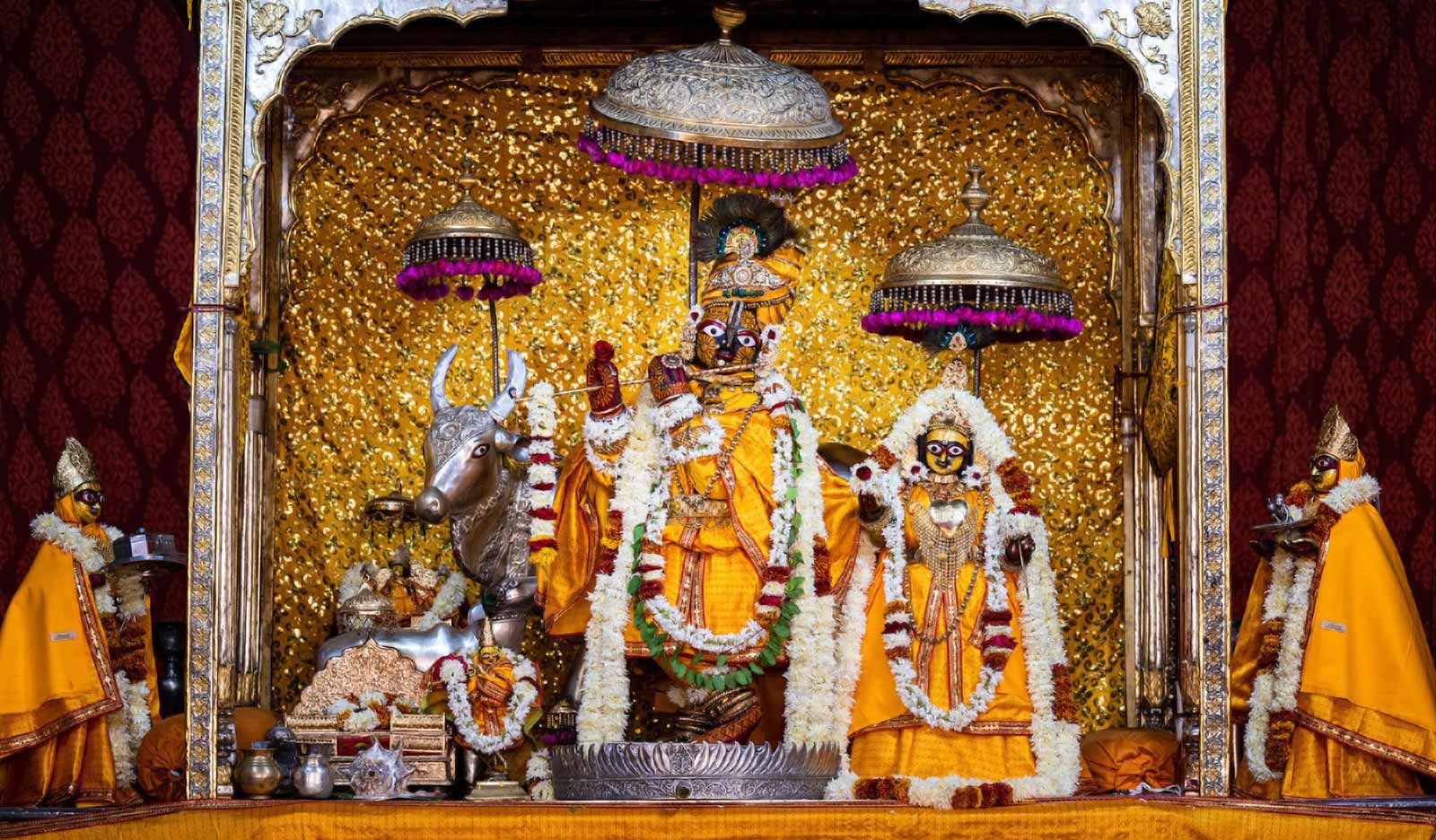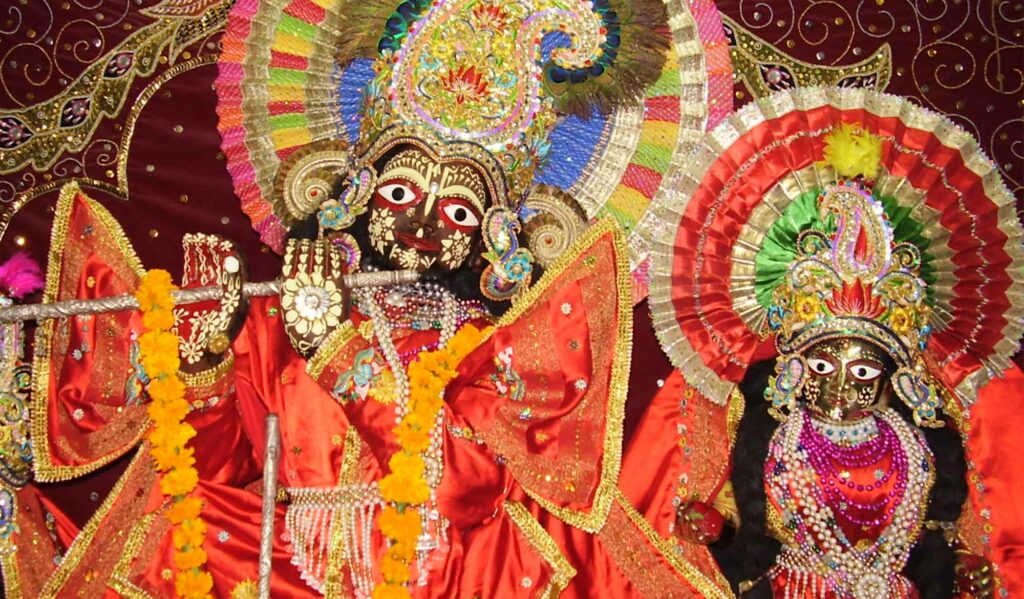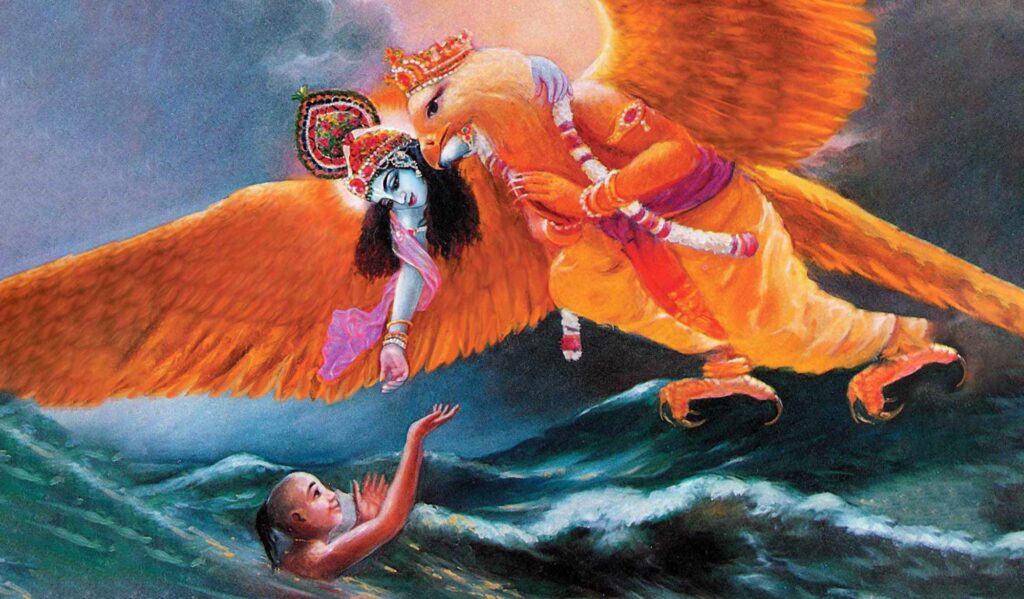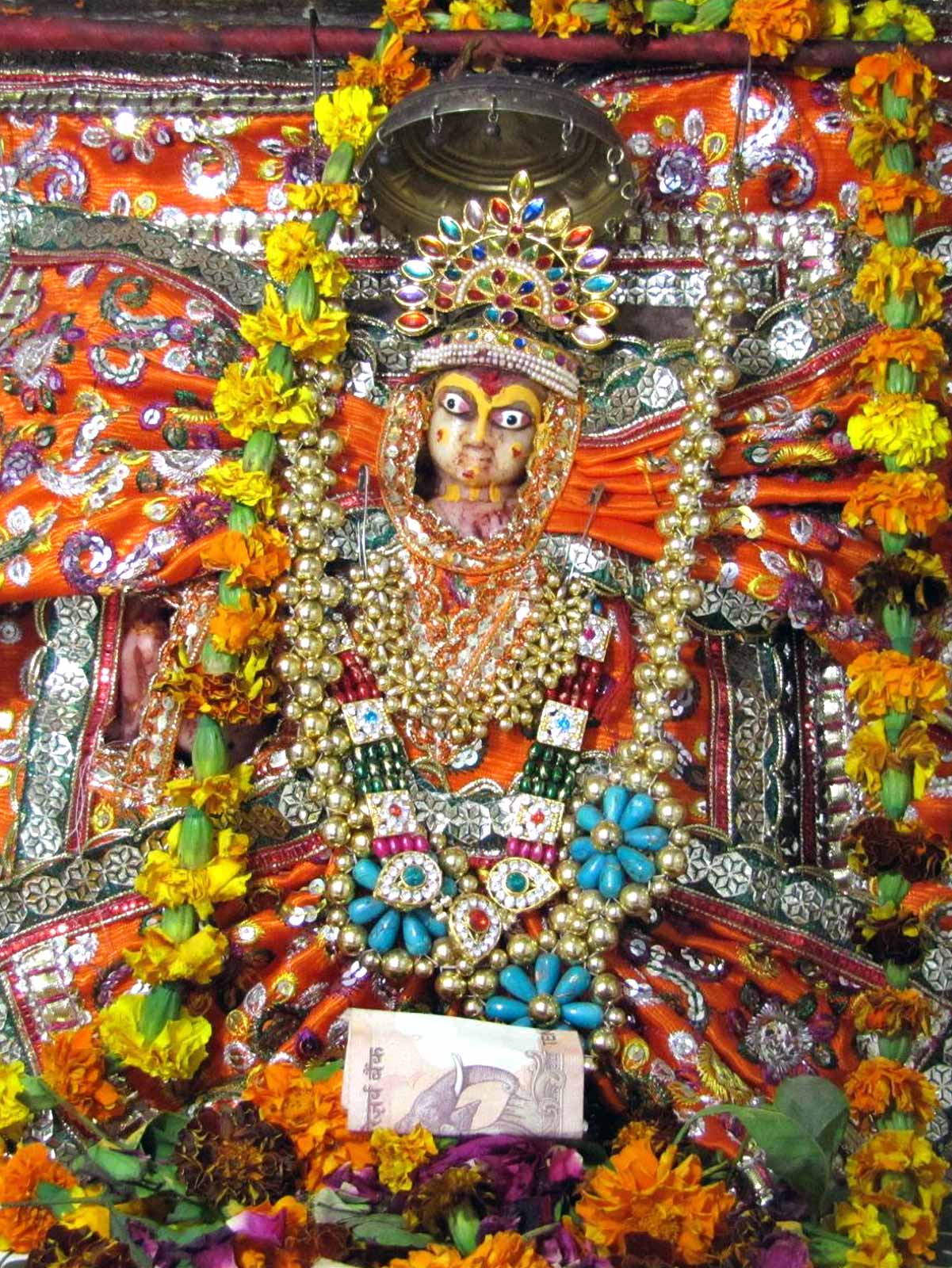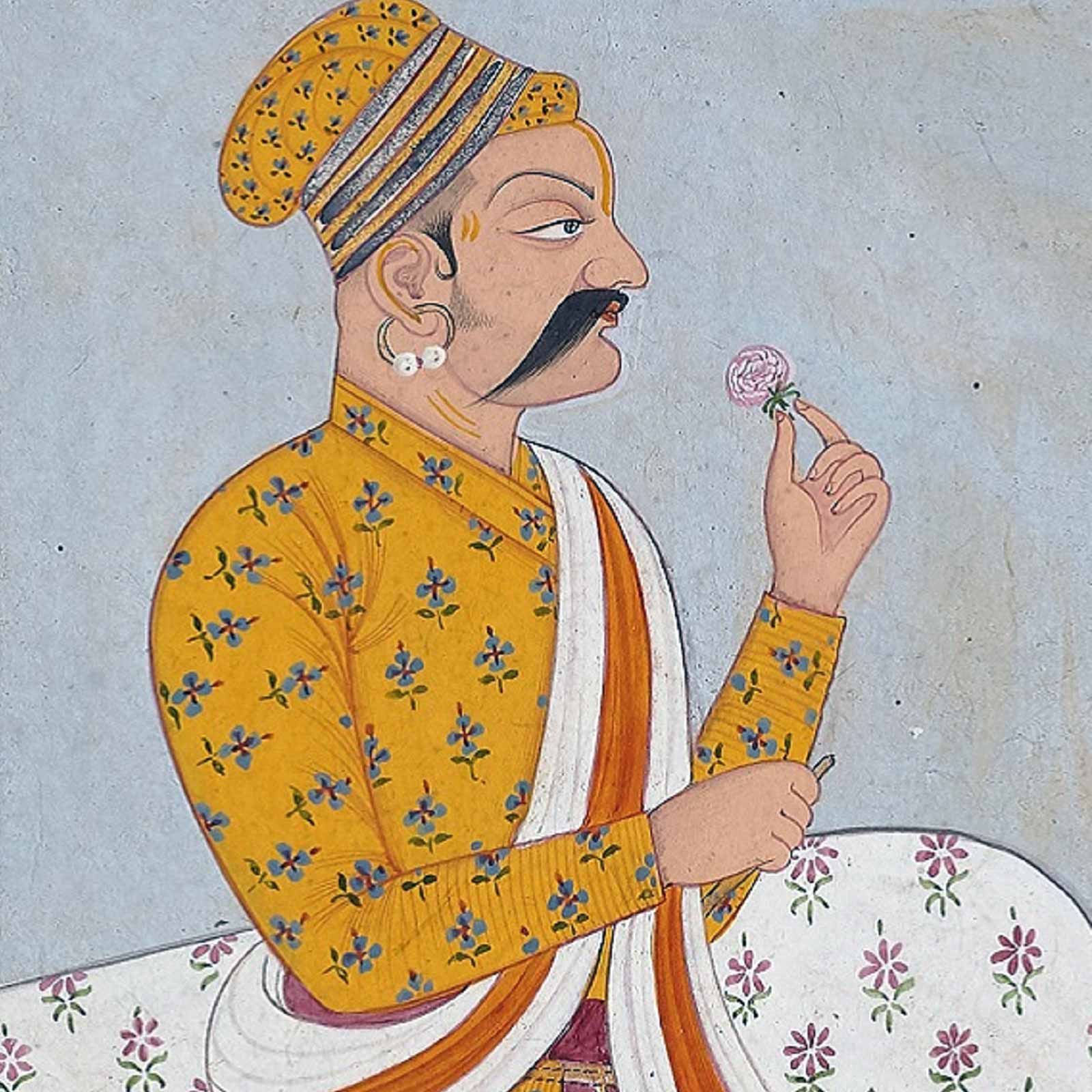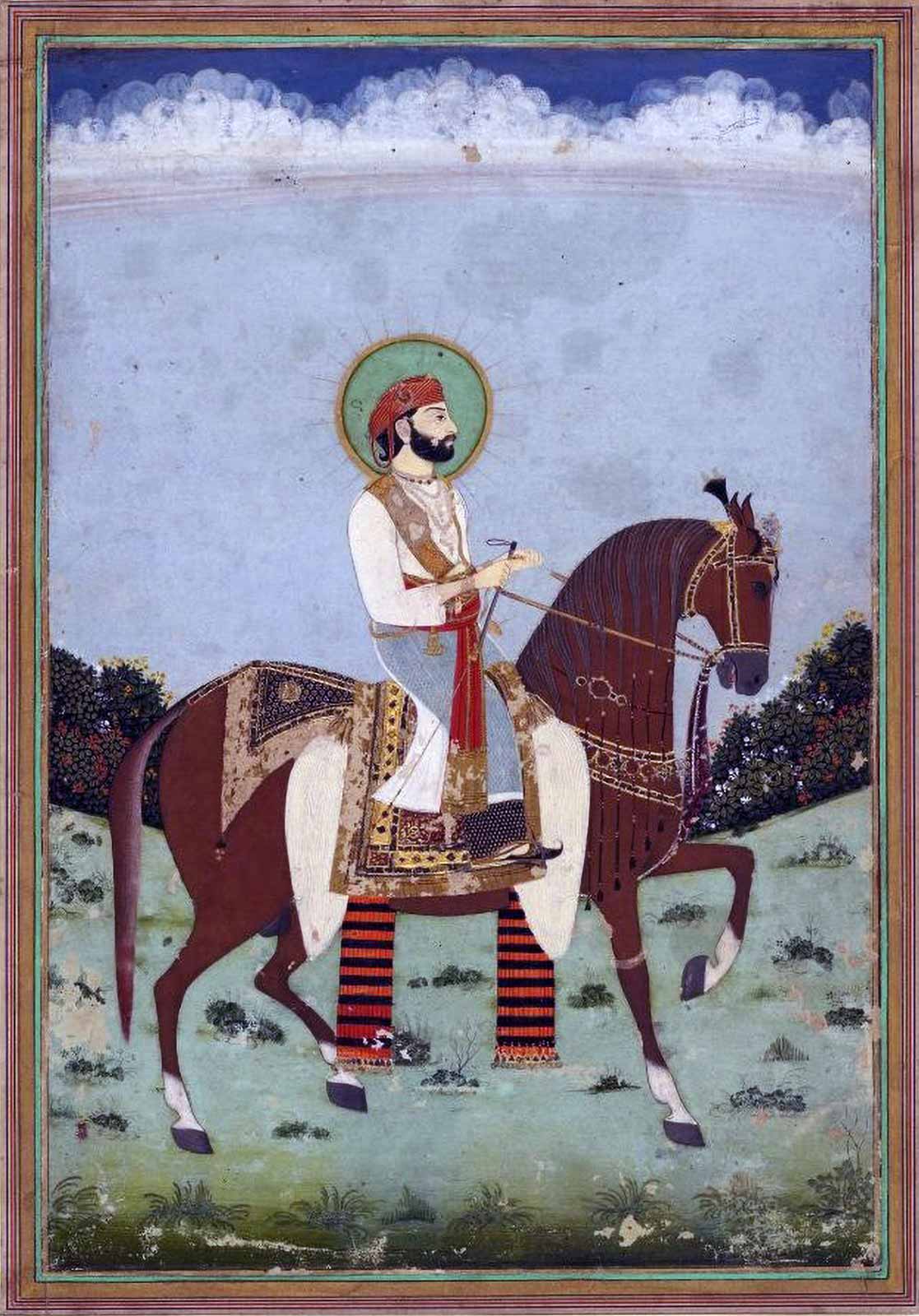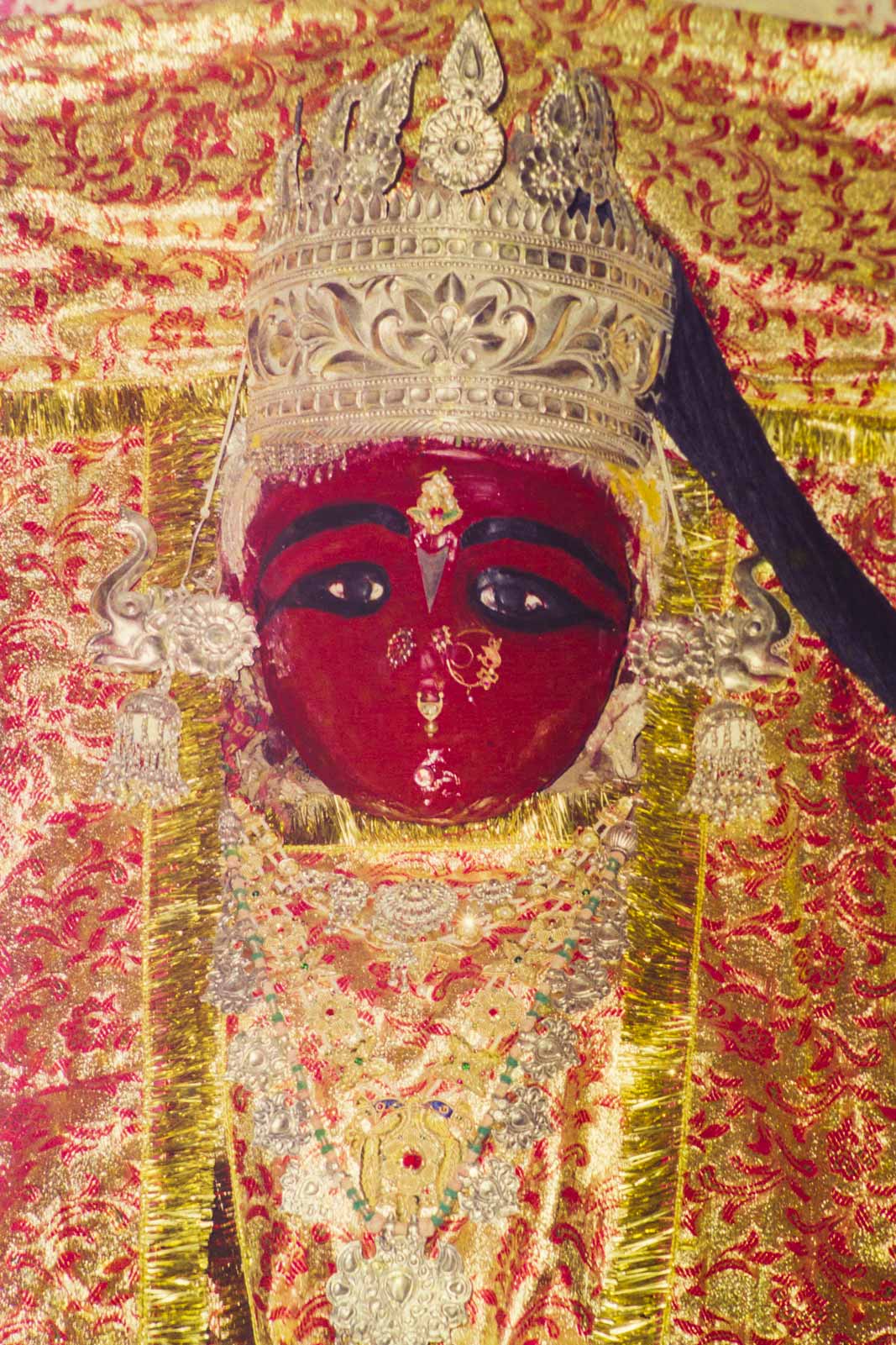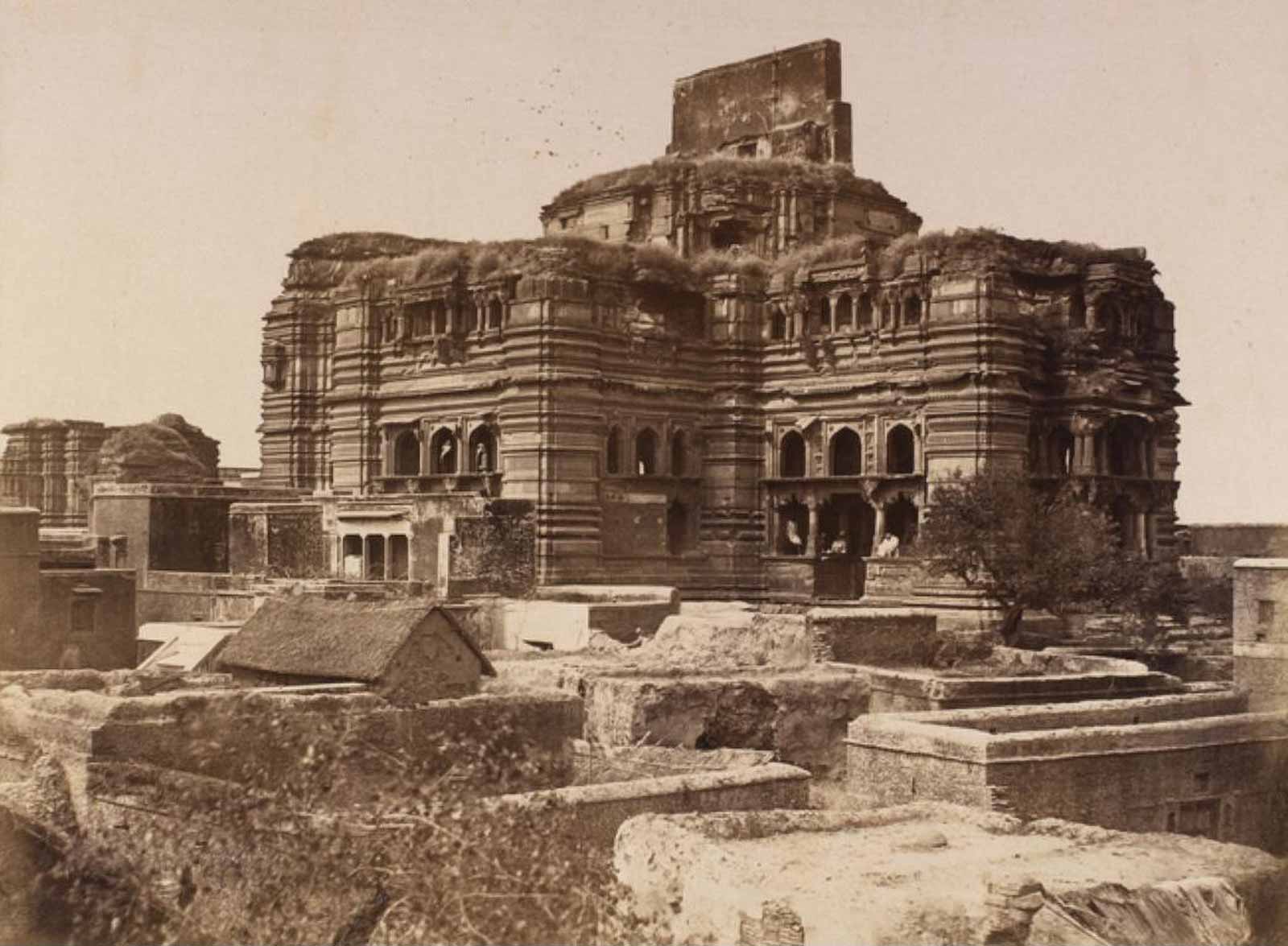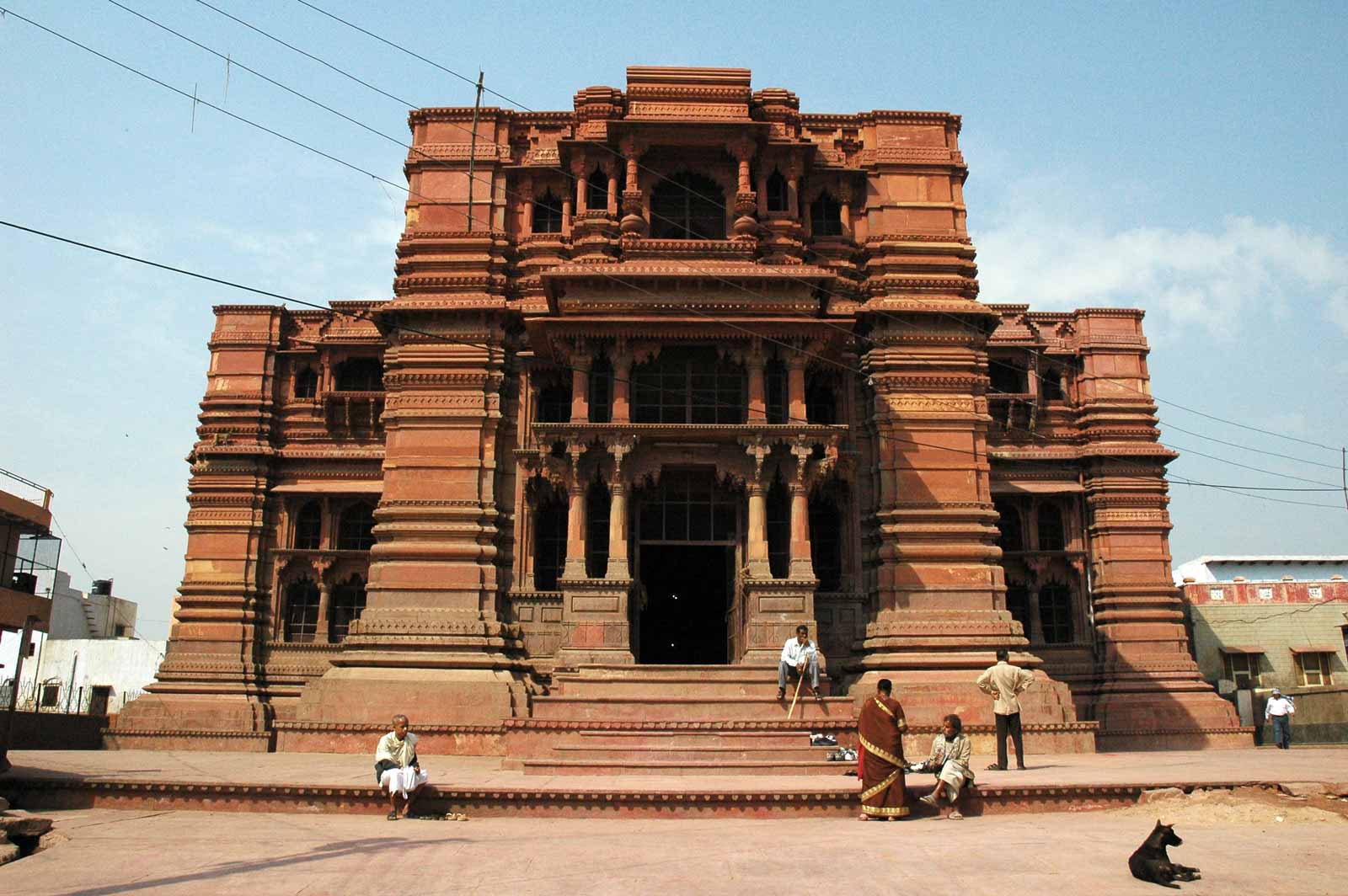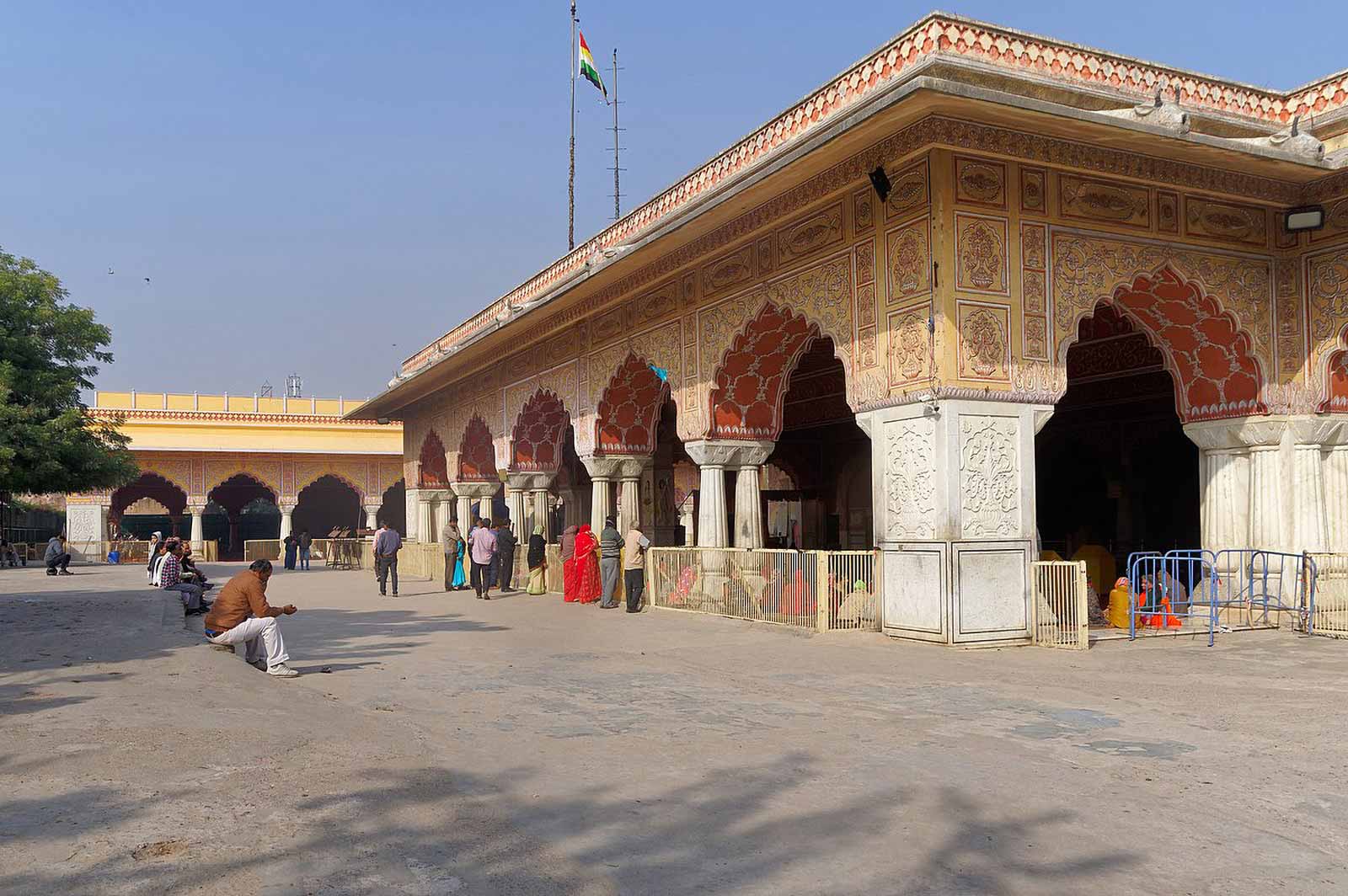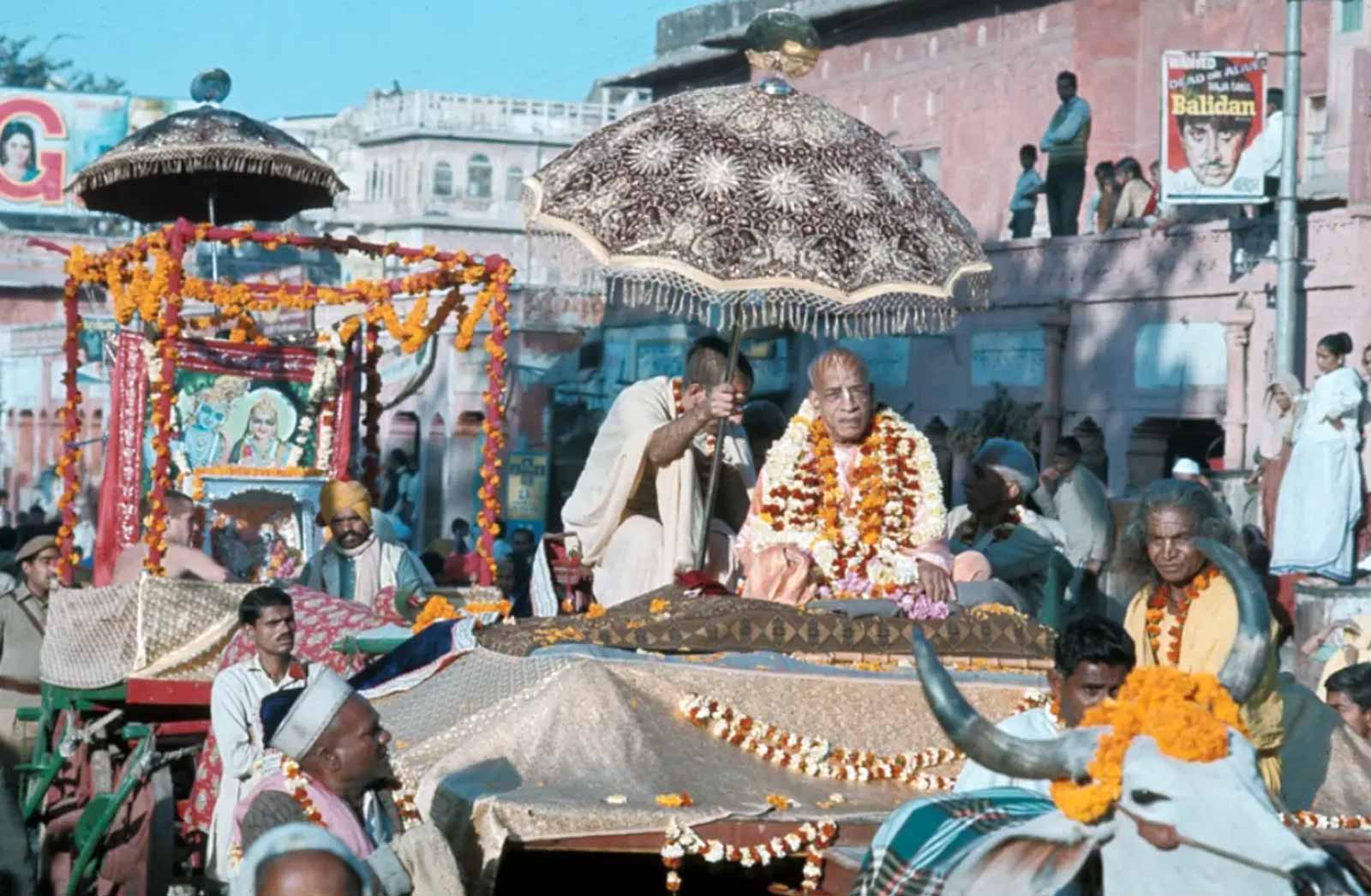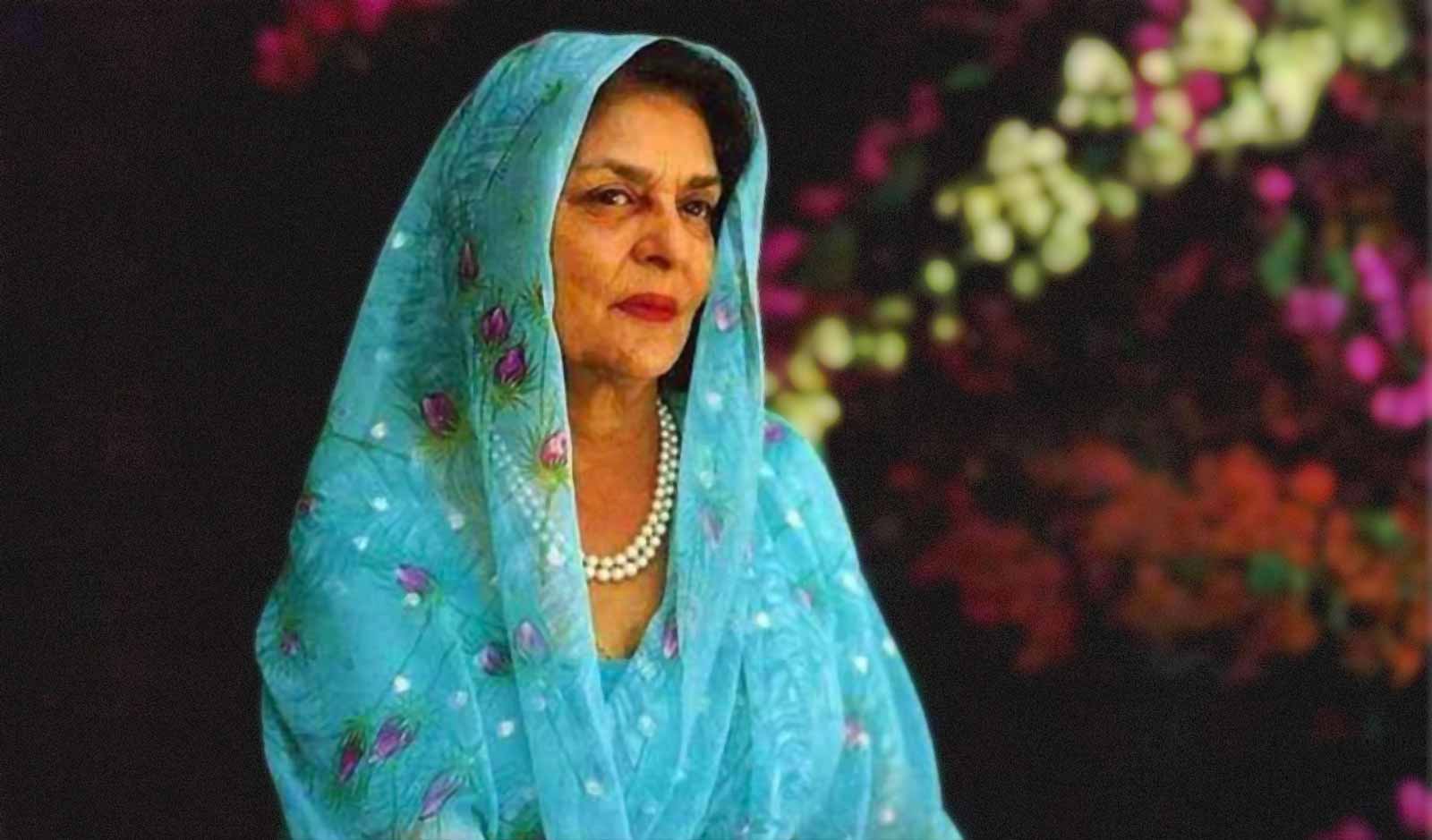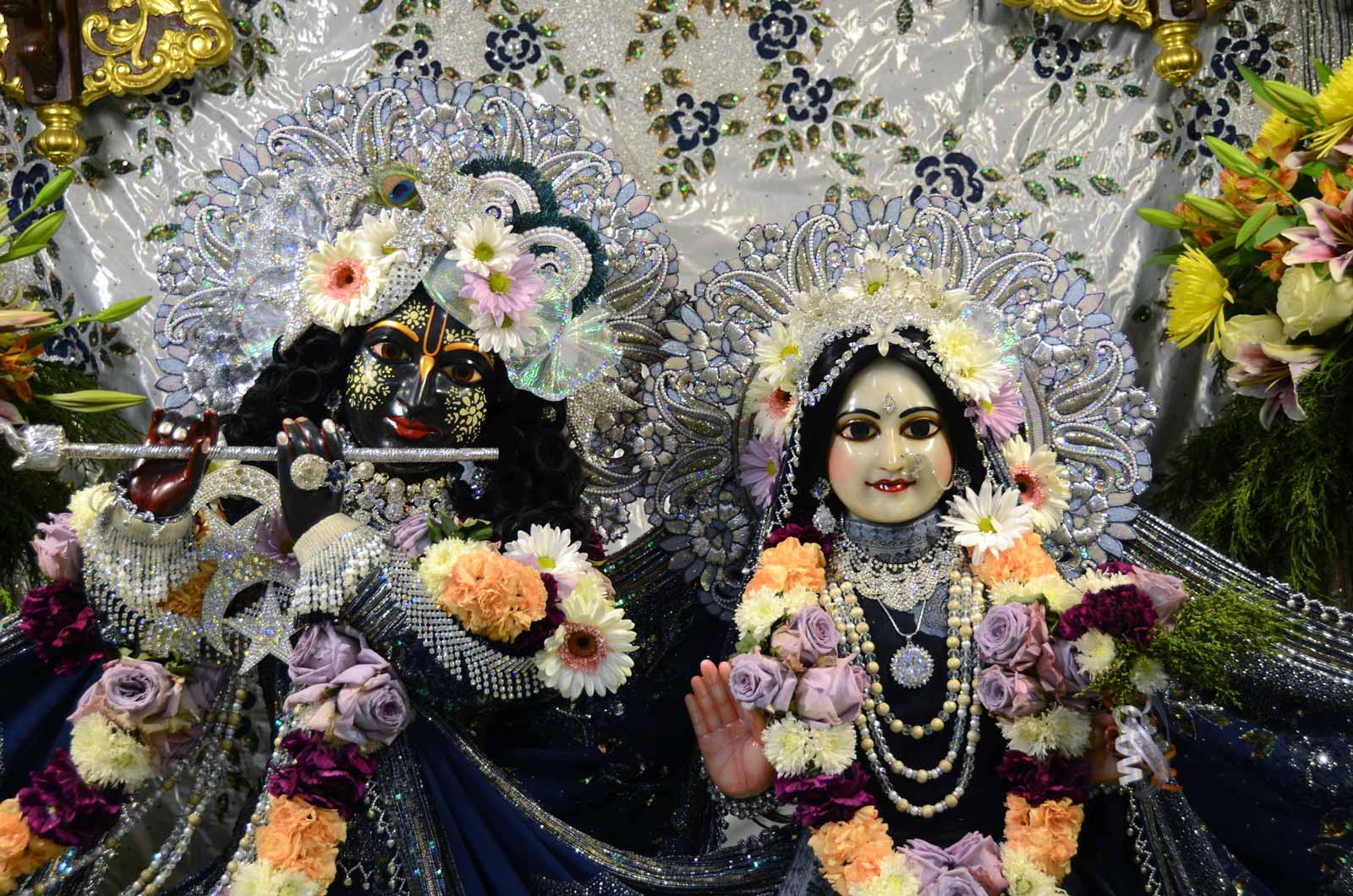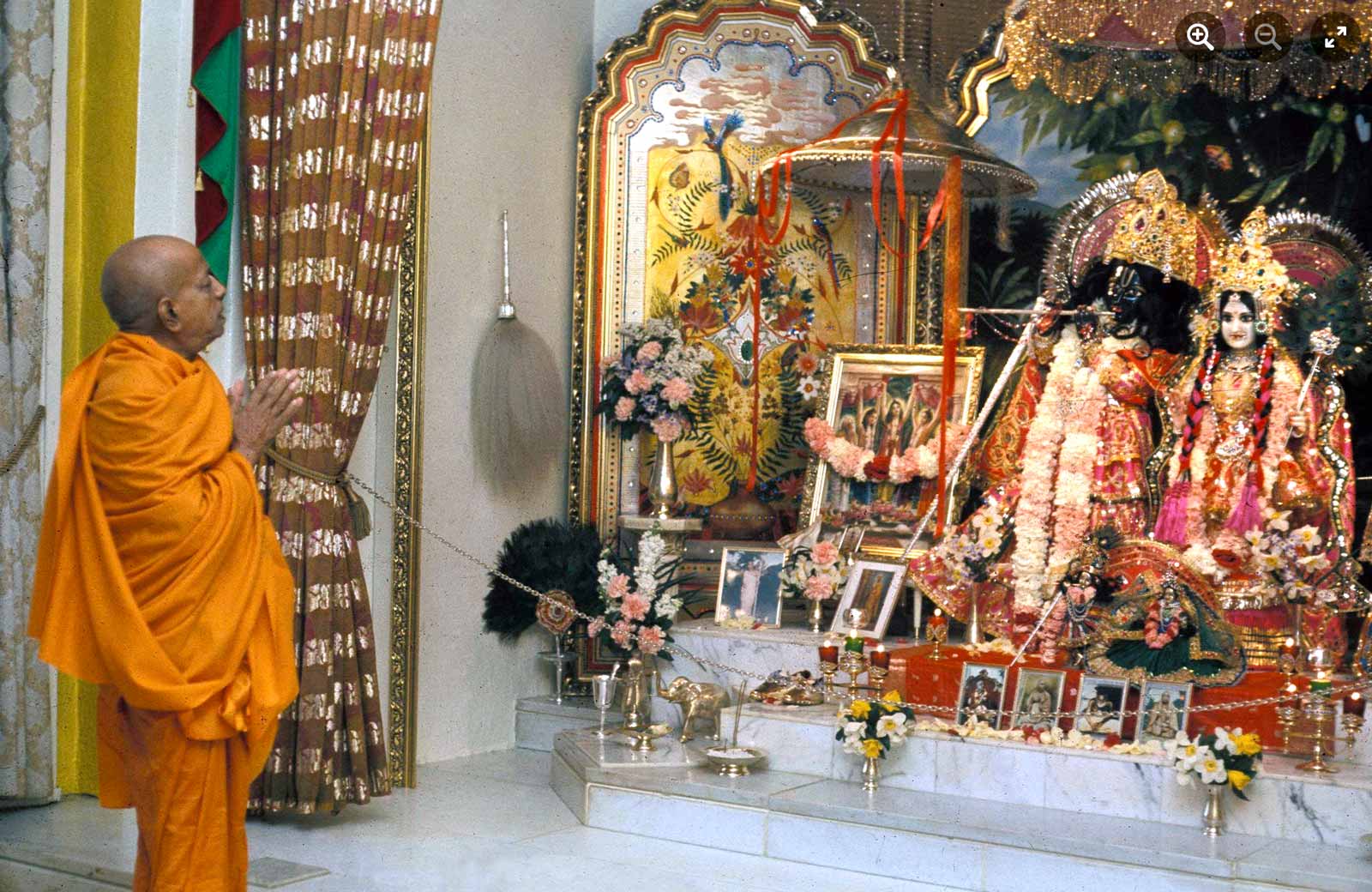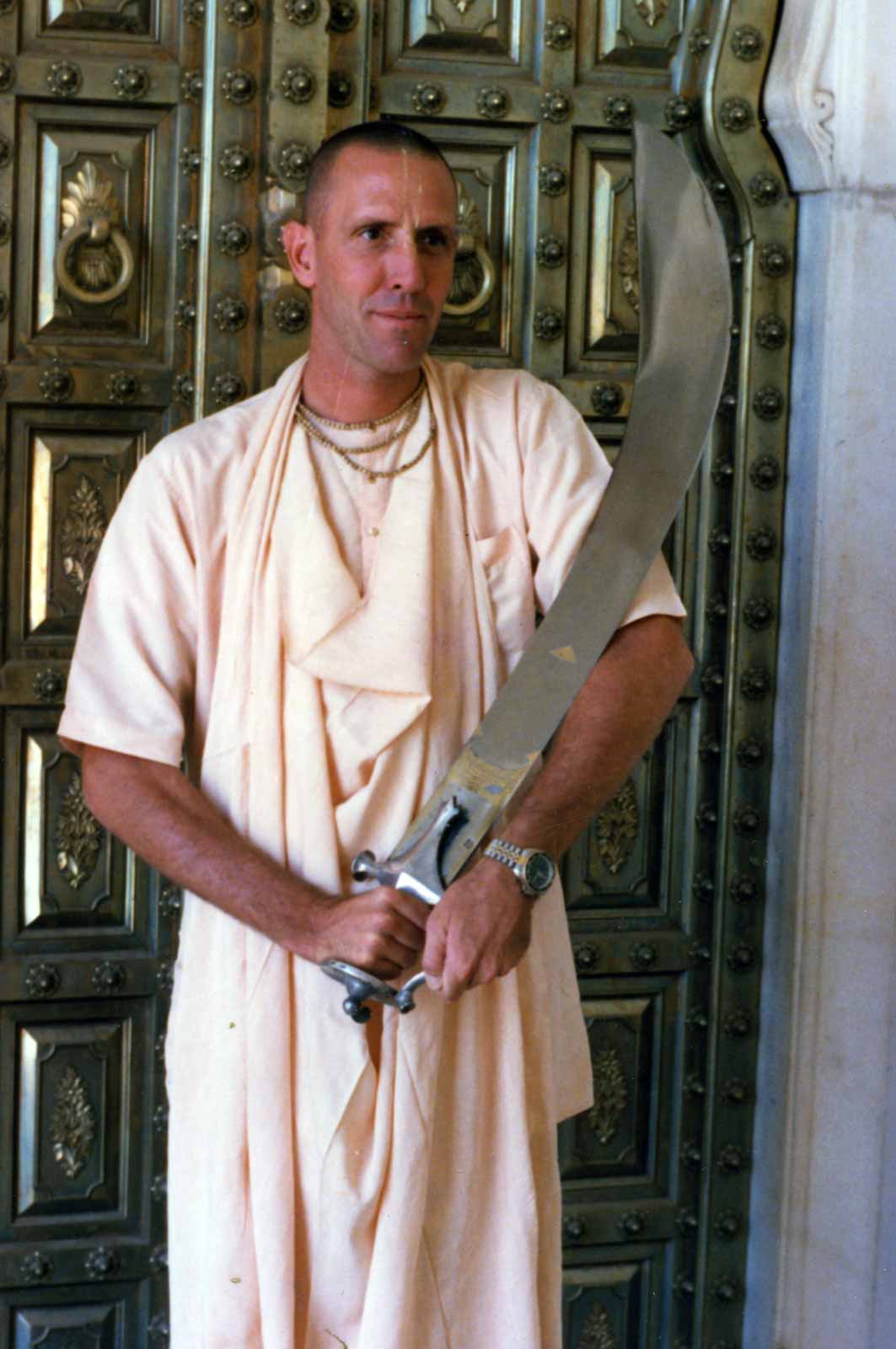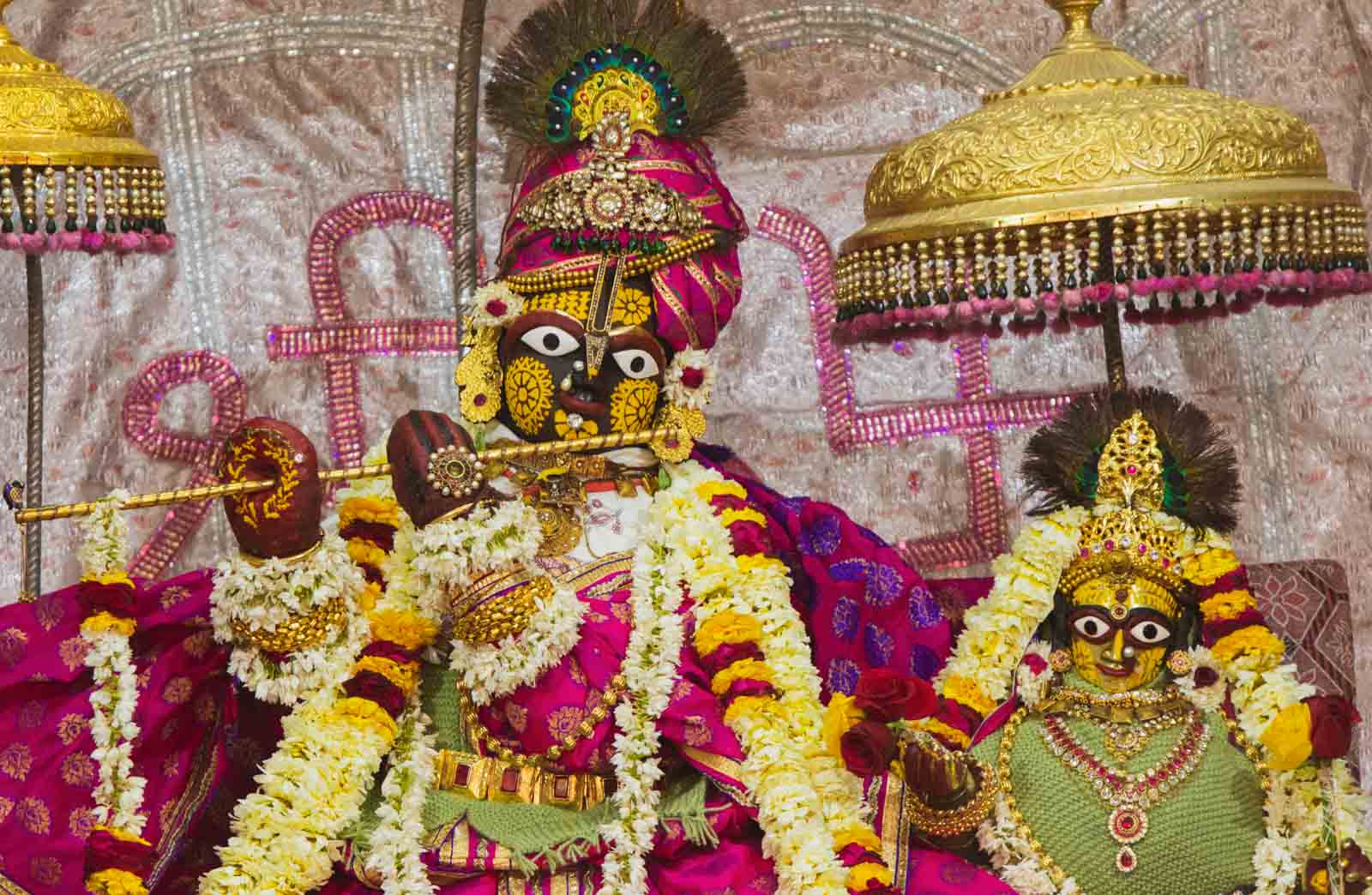Overview
Continuing with our pilgrimage with Śrīla B.G. Narasiṅgha Mahārāja, this week, Mahārāja discusses Śrī Śrī Rādhā-Govinda Mandira in Vṛndāvana, how Govindajī was eventually taken to Jaipur, and Śrīla Prabhupāda’s visit to Jaipur in 1972. This article was adapted from two talks in 1996 and 1997
In Kṛṣṇa’s pastimes, He is known as Govinda, meaning the king of the cows. After Kṛṣṇa lifted Govardhana Hill, Indra came with his Airāvata elephant and bathed Krsna with milk from Surabhi, the divine cow, and from then on Kṛṣṇa was called Govinda. This is one of Kṛṣṇa’s principal Names.
All the oldest Deities in Vraja were established by Uttarā, the mother of Parikṣit Mahārāja, and Vajranābha, the king of Mathurā and great grandson of Kṛṣṇa. Govinda, Gopinātha, Madana-mohana, Daujī, Gopāla, Keśavajī, the four kṣetra-pālas (śiva–liṅgas), Yogamāyā, Vṛndā Devī, Yaśodā-Nanda in Nandagrāma – all these Deities were installed by Vajranābha and Uttarā after Kṛṣṇa’s disappearance. Uttarā was the last person to have personally seen Lord Kṛṣṇa, so all the Deities of Him were prepared under her approval and guidance.
Later, when the Muslims invaded North India, many of the Deities of Vraja were hidden in the ground so that they would not be destroyed by them. Then in the 1500s, Rūpa and Sanātana were sent by Mahāprabhu to Vṛndāvana to uncover all the lost holy places there. At that time, Govindajī appeared to Rūpa Gosvāmī in a dream and told him where He was buried.
At the side of the present temple, there is an underground room, and if you go there on a day which is not so busy, the pūjārī can take you down there. That room is where Govindajī was first discovered. When they dug down fifteen to twenty feet, there was a vault with a big stone slab on top, and when they moved the slab, they found Govindajī. Along with Him there was a small Deity of Yogamāyā who is still worshipped there in that room today. Around the same time, a Deity of Vṛndā Devī was discovered by Rūpa Gosvāmī in Brahma-kunḍa and he installed her on the right side of Govindajī.
(Deity of Yogamāyā-devī)
Rūpa Gosvāmī began the worship of Govindajī but wanted to build a proper temple for Him. He was a sādhu with no money and no facility to do that. So some time later, Man Singh, the commander-in-chief of Emperor Akbar’s army, came with his father and they offered to build the temple. They constructed a grand, seven storey temple for Govindajī made from red sandstone. At that time, only the Moghul emperors were allowed to built with red sandstone, but Man Singh was able to convince Akbar to grant permission to use it.
(Mahārāja Man Singh)
When the original Deities of Vṛndāvana were all first established, they were not installed with Śrīmatī Rādhārāṇī. She was a secret in Vṛndāvana. Although there were a few places where there was some indication of Her, such as the writings of Jayadeva Gosvāmī. Her position was quite obscure and She was not even easily ascertainable from the Bhāgavatam. Śrīmatī Rādhārāṇī’s prominent position only became known due to Śrī Caitanya Mahāprabhu, and later through His followers.
It is said that Jāhnava Devī, the wife of Lord Nityānanda Prabhu, had the first Deity of Rādhārāṇī made and sent to the Gopīnātha temple in Vṛndāvana. Mahārāja Pratāparudra’s son had two Deities of Rādhārāṇī made for the Govinda and Madana-mohana temples, but after he sent them, the pūjārī of Madana-mohana had a dream and the Deity told him that both Rādhārāṇīs should be placed either side of Him because one was Rādhārāṇī and the other was actually Lalitā Devī. When this was done, Pratāparudra’s son was confused – what to do? Now Govindajī didn’t have Rādhārāṇī. Then the prince also had a dream where Rādhārāṇī told him, “I am in the temple of Lord Jagannātha being worshipped as Lakṣmī. I was in Vraja before, but I was brought here by one brāhmaṇa to Purī. Please make arrangements for Me to join Govinda in Vṛndāvana.”
So the next morning, the prince had that Deity of Rādhārāṇī sent to Vṛndāvana to be with Govinda. The Deity was brought to Vṛndāvana overland to the Ganges and then they put Her on a boat. They pulled that boat all the way up the Ganges to Allahabad where the Yamunā touches the Ganges, and they came all the way up the Yamunā to Keśi Ghāṭa and brought Her to be installed alongside Govindajī. Actually, if you look carefully, the Deity of Rādhā is much smaller than Govinda, and She is standing on a pedestal.
Architecturally, the temple of Rādhā-Govinda was the most prominent temple in Vṛndāvana. All the Gosvāmīs and their disciples would come there and celebrate major festivals like Janmāṣṭamī, even if they had their own temples and Deities. I heard that on Janmāṣṭamī, the devotees at Rādhā-ramaṇa Temple would finish the abhiṣeka for Rādhā-ramaṇa at midday instead of midnight, and then they would all come to Rādhā-Govinda Temple to observe the program there.
Things continued in this way up until the 18th Century when the Moghul emperor Aurangzeb decided to destroy the temple. He was famous for destroying temples and Deities. He wouldn’t just mess something up – he would demolish the whole thing all the way to the ground and then establish a mosque where it used to be. He did this in Mathurā at Kṛṣṇa’s birthplace and in Benares at the Viśvanātha temple also. Apparently, there was a lamp burning on the very top of the Rādhā-Govinda Temple in Vṛndāvana, and the legend is that one night, Aurangzeb saw the lamp from his fort in Agra and became so angry that he decided to demolish the temple. I have my doubts about this story – I don’t think you could see a lamp burning on top of a temple in Vṛndāvana all the way from Agra even on a clear night. My theory is that Aurangzeb may have been angry because the temple had originally been built using red sandstone, which was exclusively used by the Moghul emperors. Whatever the case, Aurangzeb sent his army to destroy the temple, but news had already gotten to Sawai Jai Singh, the ruler of Jaipur. Except for Rādhā-ramaṇa who is very small, all the main Deities of Vṛndāvana are quite big, so They had to be moved elsewhere, out of Vraja. Sawai Jai Singh put Rādha-Govinda and Vṛndā Devī on bullock carts and first took Them to Kāmyavana, which is still Vraja-maṇḍala, but is actually in Rajasthan. It is on the edge of a desert. The history says that the Deities stayed there for one year.
(Sawai Jai Singh II)
From Kāmyavana, Rādhā-Govinda moved on to Jaipur, but Vṛndā Devī remained. When they placed her on the bullock cart going to Jaipur, it wouldn’t move. Extra bullocks and men tried to push it, but it didn’t budge. Vṛndā Devī did not want to leave Vṛndāvana, so she remained in Kāmyavana and is still there today.
(Vṛṇdā-devī in Kāmyavana)
Anyhow, the temple of Rādhā-Govinda in Vṛndāvana was destroyed, but Aurangzeb only managed to demolish the top four storeys. According to oral history, the Moghul army was disfiguring the Rādhā-Govinda temple and other places in Vraja that day, but suddenly there was a big huṅkāra – a huṅkāra means a loud sound from the sky, and there was an earthquake. When there is an earthquake what happens to the animals? They all start scattering and moving around. So the horses and elephants started running amok. Everybody panicked and abandoned the project. There was a Hanumān temple near Govindajī, and some people say the sound was Hanumān striking his club on the ground in a fit of anger. Something must have happened – the fact they didn’t finish their ghastly work and follow it up with their usual procedure of building a mosque there suggests that something did scare them off. After that, things went downhill for Aurangzeb and the whole Moghul empire began to slowly fall apart.
(Govindaji temple in Vṛṇdāvana in 1879 (left) and present day (right))
With the Moghul empire crumbling, many Hindu kings broke off and asserted themselves in their own kingdoms. Sawai Jai Singh was rising and had become very wealthy because his grandfather was Man Singh, Akbar’s commander. He had begun building the city of Jaipur in a beautiful area with forests and lakes which was about 15-20 kilometers from Amber, the old city which had been built in the Fourth Century. Amber was out on the plains and its fortifications surrounded the city of Jaipur.
It took Sawai Jai Singh fifteen years to build Jaipur and he placed his palace at it’s centre. Near to the palace, a temple was built for Rādhā-Govinda. When the king’s palace was inaugurated, there was a big procession and the king and his entourage travelled on a huge four storey gold and silver chariot which was pulled by six elephants. Then on the night that he moved into his new palace, the king had a dream where Lord Govinda came and kicked him out of his bed onto the floor. It wasn’t a small cot either – it was pretty high off the ground. So when he hit the floor, he shouted and when the guards ran in, they found him slumped on the floor. He called his brāhmaṇas and recounted the dream and they ascertained that, “Actually you’ve occupied the centre of the city, but Govinda should occupy the centre.” So with that, the king moved out of his palace and rebuilt his residence nearby. Then Govindajī came to the palace in the centre of the city and has been there ever since.
(Govindaji temple in Jaipur)
A few years later, there was a controversy coming out of Galta from the Rāmānandī section. The Rāmānandīs are an offshoot from the Rāmānuja sampradāya – in North India you see them everywhere. They wear big, big tilaka which looks a little like Śrī Vaiṣṇava tilaka. They mostly worship Sītā-Rāma, but they have a tinge of māyāvāda in them. Anyhow, they challenged the Gauḍīyas that, “If you are a bona-fide sampradāya, where is your commentary on Vedānta–sūtra? Every sampradāya has a commentary!” Gauḍīyas consider the Śrīmad Bhāgavatam to be the natural commentary on Vedānta, so they were not so concerned with that. But this challenge from the Rāmānandīs in Galta came and they took it to Sawai Jai Singh and told him that unless the Gauḍīyas could produce a Vedānta–sūtra commentary, then they could not claim to be a bona-fide sampradāya. And if they were not a bona-fide sampradāya, they had no right to worship Govindajī in Jaipur. So Baladeva Vidyābhūṣaṇa came to Jaipur and wrote his commentary on Vedānta called the Govinda Bhāṣya. It is said that Govindajī Himself dictated it to Baladeva or inspired him from within. When Baladeva presented his commentary to the Rāmānandīs, they were all silenced.
A few years ago, a sophisticated section amongst the vrajavāsīs wrote a polite letter to the King of Jaipur requesting him to return Govindajī back to Vṛndāvana. The king replied, “Govindajī has been a guest in our city here for the last three hundred years. He is the independent Supreme Lord. If He wishes to leave by His own choice I cannot restrict Him, but neither can I ask Him to leave.” When the vrajavāsīs saw the mood of the king, they were very happy with that.
(A.C. Bhaktivedānta Swami Prabhupāda in Jaipur (left) and Gāyatrī Devī the queen of Jaipur (right))
Śrīla Prabhupāda came to Jaipur in 1972 as a guest of the Rāja-māta, the queen of Jaipur. Her name was Gāyatrī Devī and she was very pious. Śrīla Prabhupāda held a big pandal program behind the Govindajī temple and Gāyatrī Devī was extremely impressed. That was the first time anyone had seen such a thing. Gāyatrī Devī was very inspired and wanted to give a special set of Rādhā-Kṛṣṇa Deities to Śrīla Prabhupāda that she had been keeping in the palace which had not been worshiped for a long time. Śrīla Prabhupāda accepted those Deities and they were put on the stage in the pandal. After the program was over, the Rādhā-Govinda Deities were boxed up and sent to be worshiped at the New York temple.
(A.C. Bhaktivedānta Swami Prabhupāda and the Rādha-Govinda Deities in New York city)
In 1988, I wrote an article for Clarion Call magazine about Jaipur, and I went there and met with Rāja-mātā Gāyatrī Devī who was in her seventies at that time. She was very accommodating and helpful. When I told her I was a disciple of Śrīla Prabhupāda she spoke about her meeting with Prabhupāda in 1972 and I could clearly see her appreciation for him. When she heard that I was doing an article on Jaipur and Govindajī, she immediately told her personal secretary to allow me full access to the Palace Museum and to allow me to take photos there.
(Swami B.G. Narasiṅgha Mahārāja holding the sword of Man Singh in the Jaipur palace museum in 1988)
Govindajī is the main Deity of our sampradāya. We are rūpānugas, the followers of Śrīla Rūpa Gosvāmī, who establishes abhidheya, the process of Kṛṣṇa consciousness. Govindajī is the Deity of Rūpa Gosvāmī, so He represents abhidheya-tattva. After understanding sambandha-jñāna (knowledge of our relationship with Kṛṣṇa) we are mostly concerned with abhidheya. Abhidheya means service – service to the spiritual master, service to the Vaiṣṇavas, service to Tulasī, and service to the Deity. That is our main concern here in this world. Service is our only necessity and that is presided over by Govindadeva.
(Śrī Śrī Rādhā-Govinda Dev Ji in Jaipur)
Related Articles and Books
- 📚Pilgrimage With Swami Narasiṅgha Series Index
- 📖 In Search of the Ultimate Goal of Life by Śrīla A.C. Bhaktivedānta Swami Prabhupāda
- 📖 Śrī Dāmodara Kathā by Śrīla Bhakti Gaurava Narasiṅgha Mahārāja
- 📖 Prabhupāda Vijaya by Śrīla Bhakti Gaurava Narasiṅgha Mahārāja
- The Ontological Position of Śrī Śrī Rādhā-Govinda by Śrīla B.R. Śrīdhara Deva Gosvāmī
- Śrī Govardhana Pūjā by Śrīla Bhakti Rakṣaka Śrīdhara Deva Gosvāmī
- The Vṛndāvana Express and the Navadvīpa Special by Śrīla Bhakti Rakṣaka Śrīdhara Deva Gosvāmī
- Vraja Bhāva by Śrīla Bhakti Gaurava Narasiṅgha Mahārāja
- The Worship of Govardhana by Śrīla Bhakti Gaurava Narasiṅgha Mahārāja
- Dāsa Gosvāmī and the Unique Position of Govardhana by Śrīla Bhakti Gaurava Narasiṅgha Mahārāja
- Ācāryas at Śrī Śrī Rādhā-Dāmodara Temple, Vṛndāvana by Śrīla Bhakti Gaurava Narasiṅgha Mahārāja
- Pilgrimage to Vṛndāvana-dhāma by Śrīla Bhakti Gaurava Narasiṅgha Mahārāja
- The Appearance of Rādhā-kuṇḍa by Śrīla Bhakti Gaurava Narasiṅgha Mahārāja
- Prema Dhāma Deva Stotram with the Narasiṅgha Sevaka Commentary – Verses 41-45 (regarding Imlitalā) by Swami B.V. Giri
Further Reading
Pilgrimage with Swami Narasiṅgha – Part 7: Keśī Ghāṭa
Continuing with our pilgrimage series, this week Śrīla Narasiṅgha Mahārāja takes us to Keśī Ghāṭā where he tells us about Madhumaṅgala’s meeting with the Keśī demon, what Keśī represents, and how Śrīla Prabhupāda almost acquired Keśī Ghāṭa. Mahārāja also narrates his own experience. This article has been adapted from a number of talks and articles by Narasiṅgha Mahārāja.
Prema Dhāma Deva Stotram with the Narasiṅgha Sevaka Commentary – Verses 61-65
In verses 61 to 65 of 'Prema Dhāma Deva Stotram', Śrīla Śrīdhara Mahārāja narrates the pastime of Śrī Caitanya at Caṭaka Parvata In Purī and explains how the scriptures produced by Brahmā and Śiva are ultimately searching for the personality of Mahāprabhu who is merciful too all jīvas, no matter what their social position.
Prabhupāda Śrīla Sarasvatī Ṭhākura’s Visit to Ayodhyā
With the forthcoming observance of Śrī Rāma Navamī, we present 'Prabhupāda Śrīla Sarasvatī Ṭhākura’s Visit to Ayodhyā' written by Śrīla Bhaktisiddhānta Sarasvatī Ṭhākura Prabhupāda from The Gaudīyā magazine, Vol 3. Issue 21/ In December 1924, after visiting Benares and Prāyāga, Sarasvatī Ṭhākura visited the birth-site of Śrī Rāmācandra in Ayodhyā.
Śaraṇāgati – The Only Path to Auspiciousness
In this article, 'Śaraṇāgati - The Only Path to Auspiciousness', Dhīra Lalitā Dāsī analyses the process of śaraṇāgati (surrender) beginning with śraddhā (faith). She also discusses the role of śāstra and the Vaiṣṇava in connection with surrender.
Pilgrimage with Swami Narasiṅgha – Part 7: Keśī Ghāṭa
Continuing with our pilgrimage series, this week Śrīla Narasiṅgha Mahārāja takes us to Keśī Ghāṭā where he tells us about Madhumaṅgala’s meeting with the Keśī demon, what Keśī represents, and how Śrīla Prabhupāda almost acquired Keśī Ghāṭa. Mahārāja also narrates his own experience. This article has been adapted from a number of talks and articles by Narasiṅgha Mahārāja.
Prema Dhāma Deva Stotram with the Narasiṅgha Sevaka Commentary – Verses 61-65
In verses 61 to 65 of 'Prema Dhāma Deva Stotram', Śrīla Śrīdhara Mahārāja narrates the pastime of Śrī Caitanya at Caṭaka Parvata In Purī and explains how the scriptures produced by Brahmā and Śiva are ultimately searching for the personality of Mahāprabhu who is merciful too all jīvas, no matter what their social position.
Prabhupāda Śrīla Sarasvatī Ṭhākura’s Visit to Ayodhyā
With the forthcoming observance of Śrī Rāma Navamī, we present 'Prabhupāda Śrīla Sarasvatī Ṭhākura’s Visit to Ayodhyā' written by Śrīla Bhaktisiddhānta Sarasvatī Ṭhākura Prabhupāda from The Gaudīyā magazine, Vol 3. Issue 21/ In December 1924, after visiting Benares and Prāyāga, Sarasvatī Ṭhākura visited the birth-site of Śrī Rāmācandra in Ayodhyā.
Śaraṇāgati – The Only Path to Auspiciousness
In this article, 'Śaraṇāgati - The Only Path to Auspiciousness', Dhīra Lalitā Dāsī analyses the process of śaraṇāgati (surrender) beginning with śraddhā (faith). She also discusses the role of śāstra and the Vaiṣṇava in connection with surrender.


